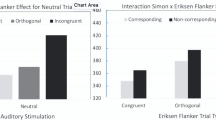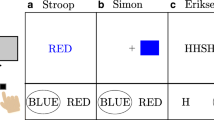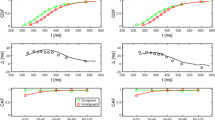Abstract.
Two possible explanations for an interaction between the Simon effect and the flanker-congruence effect (Hommel, 1997) were tested: (1) Direct contributions by the locations of the response-activating flankers to the Simon effect, and (2) the passage of time since the target's onset. In three experiments, little evidence for both explanations was observed. The data confirmed an assumed origin of the Simon effect at the stage of response selection. Further, the results are in line with the assumption that context stimuli contribute indirectly to the Simon effect of the target (i.e., by changing the target's relative position), and extend previous findings to show that the assumption holds for clearly response-activating context stimuli, too. Finally, the results suggest that Simon effects follow different time courses depending on whether they are induced by observer-relative or context-relative target positions.




Similar content being viewed by others
Notes
What might have caused the growth of the congruence effect with increasing response speed is not clear. In previous studies, the strength of the congruence effect was an inverted u-shaped function of the RT: It was strongest among intermediate RT, and was decreasing among slower and faster responses (Grice, Boroughs, & Canham, 1984). However, an RT function of the congruence effect similar to that of the present study was obtained by Hommel (1997). Hommel noted that at least the growth rate of the congruence effect was decreasing with increasing RT, and the current results resembled those of Hommel in this respect, too.
References
Ansorge, U. (2003). Spatial Simon effects and correspondence effects induced by observed gaze direction. Visual Cognition, in press
Danziger, S., Kingstone, A., & Ward, R. (2001). Environmentally defined frames of reference: Their time course and sensitivity to spatial cues and attention. Journal of Experimental Psychology: Human Perception and Performance, 27, 494–503.
Eriksen, C. W., Coles, M. G. H., Morris, C. R., & O'Hara, W. P. (1985). An electromyographic examination of response competition. Bulletin of the Psychonomic Society, 23, 165–168.
Eriksen, C. W., & Schultz, D. W. (1979). Information processing in visual search: A continuous flow conception and experimental results. Perception & Psychophysics, 25, 249–263.
Gratton, G., Coles, M. G. H., Sirevaag, E. J., Eriksen, C. W., & Donchin, E. (1988). Pre- and poststimulus activation of response channels: A psychophysiological analysis. Journal of Experimental Psychology: Human Perception and Performance, 14, 331–344.
Grice, G. R., Boroughs, J. M., & Canham, L. (1984). Temporal dynamics of associative interference and facilitation produced by visual context. Perception & Psychophysics, 33, 121–128.
Hommel, B. (1993). The role of attention for the Simon effect. Psychological Research/Psychologische Forschung, 55, 208–222.
Hommel, B. (1997). Interaction between stimulus-stimulus congruence and stimulus-response correspondence. Psychological Research/Psychologische Forschung, 59, 248–260.
Kornblum, S. (1994). The way irrelevant dimensions are processed depends on what they overlap with: The case of Stroop- and Simon-like stimuli. Psychological Research/Psychologische Forschung, 56, 130–135.
Leuthold, H., & Kopp, B. (1998). Mechanisms of priming by masked stimuli: Inferences from event-related brain potentials. Psychological Science, 9, 263–269.
Lu, C.-H., & Proctor, R. W. (1995). The influence of irrelevant location information on performance: A review of the Simon and spatial Stroop effects. Psychonomic Bulletin & Review, 2, 174–207.
Neumann, O., & Klotz, W. (1994). Motor responses to nonreportable, masked stimuli: Where is the limit of direct parameter specification? In C. Umiltà & M. Moscovitch (Eds.), Attention and performance XV: Conscious and nonconscious information processing (pp. 123–150). Cambridge, MA: MIT Press.
Nicoletti, R., & Umiltà, C. (1989). Splitting visual space with attention. Journal of Experimental Psychology: Human Perception and Performance, 15, 164–169.
Pisella, L., & Rossetti, Y. (2002). Several 'vision for action' systems: A guide to dissociating and integrating dorsal and ventral functions. In W. Prinz & B. Hommel (Eds.), Attention and performance XIX: Common mechanisms in perception and action (pp. 62–119). Oxford, UK: Oxford University Press.
Proctor, R. W., & Lu, C.-H. (1994). Referential coding and attention-shifting accounts of the Simon effect. Psychological Research/Psychologische Forschung, 56, 185–195.
Ratcliff, R. (1979). Group reaction time distributions and an analysis of distribution statistics. Psychological Bulletin, 86, 446–461.
Roswarski, T. R., & Proctor, R. W. (1996). Multiple spatial codes and temporal overlap in choice-reaction tasks. Psychological Research/Psychologische Forschung, 59, 196–211.
Sanders, A. F. (1990). Issues and trends in the debate on discrete vs. continuous processing of information. Acta Psychologica, 74, 123–167.
Simon, J. R. (1990). The effect of an irrelevant directional cue on human information processing. In R. W. Proctor & T. G. Reeve (Eds.), Stimulus-response correspondence: An integrated perspective (pp. 31–88). North-Holland: Elsevier.
Simon, J. R., & Berbaum, K. (1990). Effect of conflicting cues on information processing: The "Stroop effect" vs. the "Simon effect". Acta Psychologica, 73, 159–170.
Sternberg, S. (1969). The discovery of processing stages: Extensions of Donders' method. Acta Psychologica, 30, 276–315.
Stoffels, E.-J., & Van der Molen, M. J. (1988). Effects of visual and auditory noise on visual choice reaction time in a continuous flow paradigm. Perception & Psychophysics, 44, 7–14.
Stroop, J. R. (1935). Studies of interference in serial verbal reactions. Journal of Experimental Psychology, 18, 643–662.
Acknowledgements.
Supported by Grant No. Ne 366/6–1 from the Deutsche Forschungsgemeinschaft to Odmar Neumann. Thanks to Bernhard Hommel, Robert Proctor, Marc Brysbaert, Heike Hartwig-Jakobs, Manfred Heumann, Werner Klotz, and Odmar Neumann for helpful comments on earlier drafts of the manuscript.
Author information
Authors and Affiliations
Corresponding author
Rights and permissions
About this article
Cite this article
Ansorge, U. Influences of response-activating stimuli and passage of time on the Simon effect. Psychological Research 67, 174–183 (2003). https://doi.org/10.1007/s00426-002-0115-4
Received:
Accepted:
Published:
Issue Date:
DOI: https://doi.org/10.1007/s00426-002-0115-4




